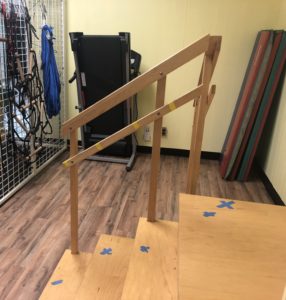
When we are encouraging or teaching a new movement, we often have to provide cueing for the child. I thought I would take a moment and breakdown 4 of the main types of cueing that are used.
- Visual – Visual cues are cues that your little one can see. This could be in any format. The following are some examples to show how varied they can be. For instance with going up and down stairs, we will sometimes use tape on the steps to encourage reciprocal stepping to show where to place the foot. This could also be a toy that lights up encouraging the child to reach for it. It could also be you doing the exercises with the child and modeling it. We do this with jumping jacks a lot of time or with a mirror. It’s anything that is used visually to encourage the movement.
- Auditory – Auditory cues are cues that your little one can hear. Again, this can look differently depending on the scenario. It may be counting to help pace the activity such as for jumping jacks. Or when a child is learning to skip or hopscotch the cues may be more about what they are supposed to be doing like ‘step hop, step hop’ or ‘one foot, two feet.’ It may be about speed or direction such as steering and riding a bicycle. Or just asking a child to do a movement a certain way and waiting for them to initiate. Rattles and toys that make noise are also auditory cues to encourage reaching or moving towards an object.
- Tactile – Tactile cues are cues that your little one may feel. It could be a light touch to remind them to use one side rather than the other. We often use tapping on the leg we want the child to lead with when going up a step. It could be something like a hand over hand for encouraging reaching. Tickling is another cue to help remind the muscle to turn on, we often use it on the core for postural control.
You can also combine cues if needed. For instance tapping their leg while saying ‘this foot’ for going up stairs. Or using a toy that lights and makes noise. What does the child need to be successful and to start to learn the skill?
Some of the reasons cues may be used are to:
- initiate movement
- sequence movement
- improve movement accuracy
The goal is to be able to gradually decrease the amount of cueing that is needed for the child to successfully initiate and complete the skill. You also need to keep in mind that some cueing may be more beneficial for kids than others. Just like you or I may learn better if we hear something versus read something, the same for kids. If a child has a type of apraxia they may have a hard time following auditory cues but do ok with visual cues or tactile cues. Same with if a child has visual challenges, they may need auditory or tactile cues. It’s also important to give time for the child to process the information before you give the cue again. And, if nothing happens after I give a verbal cue and wait a while, I might try a tactile cue the next time. It’s all about discovering the best ‘learning style’ for your little one!